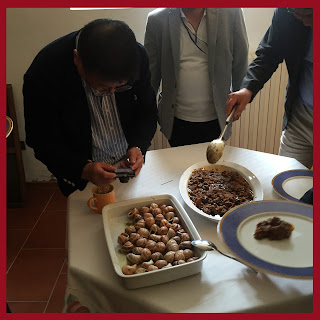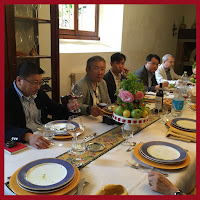Sfiziose Ricette. Le Chiocciole alla nostra maniera!
Sfiziose Ricette. Le Chiocciole alla nostra maniera!
Dal nostro ultimo viaggio in Giappone abbiamo potuto apprendere come sia popolare la cultura gastronomica italiana e come la nostra azienda sia considerata tra i baluardi che preservano la tradizione toscana a tavola.
Thanks to our last trip to Japan we were able to understand how popular the Italian gastronomic culture and how our winery is considered one of the bulwarks that preserve the Tuscan tradition to the table.
Una gradita conferma è arrivata, a pochi mesi di distanza, in occasione del viaggio-studio dei dirigenti e dello staff tecnico del colosso della ristorazione nipponica Saizeriya, nostro storico partner.
A good confirmation came a few months later, during the study tour of senior management and the coaching staff of the Japanese catering giant Saizeriya, our historical partner.
Per affinare le loro tecniche di cucina, una squadra di gourmet giapponesi sta attraversando l’Italia per cercare di carpire tutte le sfumature di alcuni piatti tipici, familiarizzando con gusti e sensazioni che per noi sono consuetudine, in modo da poterli riproporre ai loro clienti in estremo oriente.
To hone their cooking techniques, a team of Japanese chefs going through Italy with trying to understand all the nuances of some dishes, familiarizing with the tastes and the sensations that are the norm for us, so that you can propose to their customers.
Nella sosta presso il nostro podere è stato specificatamente richiesto di poter assaggiare un piatto povero, di origine contadina: le chiocciole (o lumache di terra). Ci siamo cimentati in prima persona nella preparazione del piatto, per poter accontentare i nostri ospiti, e vogliamo raccontare la nostra singolare esperienza!
In the stop at our farm we have been specifically requested to be able to taste a poor dish, of peasant origin: the snails. We ventured in person in the preparation of the dish, to be able to please our guests, and we want to tell our unique experience!
Apriamo solo una piccola parentesi prima di addentrarci nei dettagli della ricetta.
Per rendere omaggio alla delegazione giapponese, Cantine Bellini hanno consegnato direttamente al presidente del gruppo Saizeriya Issei Horino una insegna- artistica preparata da Maurizio Baccili.
We open only a small parenthesis before we get into the details of the recipe.
To pay tribute to the Japanese delegation, Cantine Bellini has delivered directly to the President of Saizeriya Issei Horino an art painting prepared by Maurizio Baccili.
La Spirale, simbolo della ciclicità e della forza della vita, è una figura che si trova spesso in natura. La sua progressione geometrica rievoca un concetto ancestrale di crescita, di evoluzione.
In questa occasione siamo riusciti a creare un vero e proprio parallelismo tra le coloratissime spirali sfuggenti delle opere di Maurizio, tra le etichette e le confezioni regalo della linea Mamb-O (messe in mostra per l’occassione) e il guscio calcificato del nostro piatto principale.
The Spiral, symbol of cyclicity and force of life, is a figure that is often found in nature. Its geometric progression evokes a concept ancestral growth, evolution.
On this occasion we were able to create a real parallel between the colorful spirals elusive of the works of Maurizio, the labels and gift Mamb-O line packages (put on display for the occasion) and the shell of our main dish.
Tornando alla nostra sfida culinaria, il primo problema che ci si presenta è come procurarci le chiocciole, l’ingrediente principale della nostra ricetta.
Un tempo, per raccogliere questi molluschi, era sufficiente, dopo la pioggia, recarsi in prossimità di un prato o di un orto. Allo stato attuale, c’è una regolamentazione molto severa per quanto riguarda la loro consumazione, quindi è bene optare sempre per animali di allevamento. In questo modo non solo si è sicuri della loro origine, ma non ci si deve occupare personalmente del lungo periodo di “spurgo” necessario per pulire il loro intestino.
Returning to our culinary challenge, the first problem that arises is how to procure the snails, the main ingredient in our recipe.
At one time, to collect these mollusks, it was enough, after the rain, go near a lawn or a garden. At present, there is a very tight regulation as regards their consummation, so it is good always opt for farmed animals. This way not only it is sure of their origin, but we do not have to personally occupy the long period of “purging” needed to clean their intestines.
Storicamente le chiocciole hanno sempre rappresentato un alimento semplice ma nutriente. La carne di lumaca non è grassa, è ricca di proteine, ferro e calcio. Si andava “a lumache” per preparare ottimi piatti, e tutt’oggi esistono diversi metodi di preparazione, cottura e condimento: al forno, in umido, al sugo, ripiene o trifolate. A loro volta queste ricette classiche hanno assunto svariate varianti regionali: ligure, calabrese, romana, pugliese, sarda, e anche toscana. In ogni caso sempre ottime da accompagnare a pane o polenta.
Historically the snails have always been a simple but nutritious food. The snail meat is not fat, is high in protein, iron and calcium. People went to “searching snails” to prepare great dishes, and always today there are different methods of preparation, cooking and seasoning: baked, stewed, with sauce, stuffed or sautéed. In turn, these classic recipes have taken many regional variants: from Liguria, Calabria, Rome, Puglia, Sardinia, and even from Tuscany. In any case, snails are more tasty if accompanied by bread or polenta.
La preparazione di questo piatto però è molto lunga e complessa! Consigliamo a chi volesse cimentarsi nel replicare la ricetta, di fare almeno qualche prova prima di offrirle ad eventuali ospiti.
Prima di tutto, al momento della preparazione, è necessario assicurarsi che tutti gli animali siano vivi.
Quindi, si può procedere al lavaggio dei molluschi e “passare le sette acque”, ovvero immergere le lumache in un recipiente con acqua ed aceto per eliminare tutta la bava e gli ultimi residui di escrementi. Il lavaggio deve durare almeno mezz’ora e deve essere rinnovato per almeno sette volte, diminuendo progressivamente la concentrazione di aceto. Per l’ultimo bagno, infine, si consiglia di usare solo acqua.
Vi proponiamo adesso entrambe le ricette che abbiamo offerto ai nostri ospiti.
The preparation of this plate, however, is very long and complex! We recommend to those who want to try to replicate the recipe to make at least some proof before offering to any guests.
First of all, at the time of preparation, you must ensure that all animals are alive.
Then, you can proceed to the washing of the snails and “pass the seven waters”, putting the snails in a container with water and vinegar to remove all burrs, and the last remnants of excrement. The washing should last at least half an hour and must be renewed for at least seven times, gradually decreasing the concentration of vinegar. For the last swim, finally, we recommend using only water.
LUMACHE AL SUGO SNAILS IN TOMATO SAUCE
Ingrdienti: Ingredients:
1,5 kg di lumache 1,5 kg of snails
2 cipolle 2 onions
2 costole di sedano 2 celery ribs
2 carote 2 carrots
200 gr di funghi porcini secchi 200 gr of dry porcini mushrooms
5 foglie di alloro 5 bay leaves
un bicchiere di a glass of
Chianti D.O.C.G. Cantine Bellini Chianti D.O.C.G. Cantine Bellini
sale salt
pepe pepper
olio d’oliva olive oil
rosmarino rosemary
nepitella o timo catmint or thymus
prezzemolo parsley
1 kg di passata di pomodoro 1 kg of peeled tomatoes
Lessare le lumache in acqua leggermente salata per circa mezz’ora.
Preparare un trito di sedani, carote, cipolle e funghi e aggiungere quindi prezzemolo, rosmarino, alloro e della nepitella (in alternativa si può utilizzare del timo).
Nel nostro podere fortunatamente possiamo cogliere queste erbe direttamente nel prato; in alternativa si possono utilizzare anche erbe essiccate.
Boil the snails in lightly salted water for about half an hour.
Make a mixture of celery, carrots, onions and mushrooms chopped and then add parsley, rosemary, bay leaves and catmint (alternatively you can use the thymus).
In our farm fortunately we can seize these herbs directly in the meadow; alternatively you can also use dried herbs.
In a crock or in a steel pot, put some olive oil and leaves the mixture until it turns golden and then add the snails and deglaze with the red wine. Now add the tomatoes, salt and pepper, and continue with slow cooking for 3 hours. Then remove the snails from their shells and allow to season the sauce.
LUMACHE AL FORNO SNAILS IN THE OVEN
Ingrdienti: Ingredients:
1,5 kg di lumache 1,5 kg of snails
1/2 cipolla 1/2 onion
1 costola di sedano 1 celery rib
1 carota 1 carrot
100 gr di funghi porcini secchi 200 gr of dry porcini mushrooms
150 gr di burro 150 gr of butter
150 gr di pecorino 150 gr of pecorino cheese
2 foglie di alloro 2 bay leaves
un bicchiere di a glass of
Bianco Toscano I.G.T. Cantine Bellini Bianco Toscano I.G.T. Cantine Bellini
sale salt
pepe pepper
olio d’oliva olive oil
rosmarino rosemary
nepitella o timo catmint or thymus
prezzemolo parsley
Lessare le lumache in acqua leggermente salata per circa mezz’ora e quindi sgusciare tutti i molluschi.
Lavare e pulire i gusci con uno spazzolino, quindi asciugarli con un panno, porli capovolti sulla placca da forno per circa 10 minuti a calore moderato in modo che si asciughino completamente.
Porre 2/3 delle lumache sgusciate in una casseruola, coprirle con il vino bianco e con uguale quantità di acqua.
A parte, preparare un trito con il sedano, la carota, la mezza cipolla e i funghi e aggiungere quindi prezzemolo, rosmarino, alloro e nepitella (o timo), salare e pepare. In una pentola lasciare imbiondire il battuto con un filo d’olio d’oliva quindi frullare il composto al mixer e aggiungere le restanti lumache. Una volta ottenuto un composto omogeneo, versarlo nella casseruo le lumache intere. Portare a ebollizione, abbassare la fiamma e far cuocere, a fuoco moderato, per un’ora e mezzo, quindi lasciar raffreddare. Scolare le lumache lasciate intere.
Servendosi di un cucchiaino, prendere un pò di questo impasto e sistemarlo sul fondo di ogni guscio, quindi rimettete nel loro guscio le lumache coprendole con dell’altro impasto. Ungere una teglia con del burro e disporvi in fila le lumache. Porre le lumache in forno preriscaldato a 180 °C per una decina di minuti.
Using a spoon, take some of this sauce and put in the bottom of each shell, then put the snails in their shells, covering with other sauce. Grease a baking dish with butter and arrange the snails in a row. Place the snails in a preheated oven at 180 ° C for ten minutes.
Entrambi i piatti, accompagnati da un corposo Sangiovese, Podere il Pozzo o 100%, sono una vera leccornia!
Both dishes, accompanied by a full-bodied Sangiovese, Podere il Pozzo or 100%, are a real treat!


















0 Comment